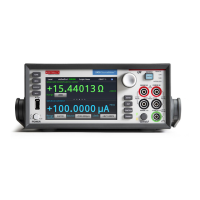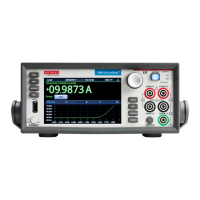3: Functions and features Model 2450 Interactive SourceMeter® Instrument
3-100 2450-901-01 Rev. B/September 2013
Dynamic limits
The branch-on-dynamic-limits building block defines a trigger model block that goes to a specified
block in the trigger model if a measurement meets user-defined criteria.
When you define this building block, you set:
• The type of limit (above, below, inside, or outside the limit values)
• Two user-defined limit sets
• The building block to go to if the measurement meets the criteria
• The building block that makes the measurement that is compared to the limits; the last
measurement from that building block is used
There are two user-defined limits: limit 1 and limit 2. Both include their own high and low values. You
set these limit threshold values as separate settings. Limit 1 and limit 2 are stored in the
measurement configuration list. You can set them to different values in different indices of the
measurement configuration list to allow you to step through different values. The results of these limit
tests are recorded in the reading buffer that accompanies each stored reading.
Delta
The branch-on-delta building block defines a trigger model block that goes to a specified block if the
difference of two measurements meets preset criteria.
The difference between the measurements is compared to the target difference. If the difference is
less than the target difference, the trigger model goes to the branching block. If the difference is more
than the target difference, the trigger model proceeds to the next block in the trigger model sequence.
If you do not define the measurement block, it will compare measurements of a measure block that
precedes the branch delta block. For example, if you have a measure block, a wait block, another
measure block, another wait block, and then the branch delta block, the delta block compares the
measurements from the second measure block.
When you define this building block, you set:
• The target difference; when the difference between the measurements is less than or equal to
this value, the trigger model goes to the specified block
• The building block to go to if the difference is less than or equal to the target difference
• The building block that makes the measurements that are compared to the limits; the last two
measurements from that building block are used
Always
When the trigger model reaches a branch-always building block, it goes to a specified building block.
Once
When the trigger model reaches a branch-once building block, it goes to a specified building block the
first time it is encountered in the trigger model. If it is encountered again, the trigger model ignores the
block and continues in the normal sequence.
You can use this block to create a bypass. For example, you might place a branch-once block before
a wait block to skip the wait block on the first pass of the trigger model.
The once block is reset when the trigger model reaches the idle state. Therefore, the branch-once
block will always execute the first time the trigger model encounters this block.

